Vaccine Cold Storage Monitoring and Tracking using LoRaWAN
Abstract
This project implements a methodology for a cold storage monitoring and tracking system built upon a LoRa network. The architecture comprises an end node with a monitoring system, a LoRaWAN Gateway, LORIOT network server and the user application. The end node has built-in temperature, pressure and humidity sensors. Force-Sensitive-Resistors and a GPS module are interfaced externally to the module. The monitoring system can thereby measure the parameters inside the chamber as well as track the chamber in real-time. Further, the presence of vaccines is detected using the force-sensitive-sensors. A web application has been designed to provide the user with an interface to analyze the network parameters, receive data from the end node, issue signals to the end node and track the cold storage during transportation.
Methodology
The proposed LoRaWAN architecture comprises four fundamental layers. An end node, a LoRaWAN Gateway, LORIOT network server, and a web-based user application interface.
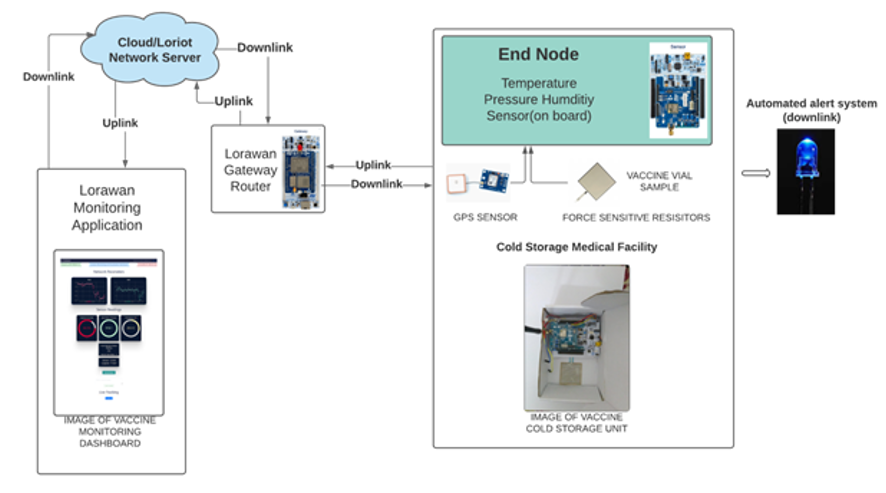
End Node
A LoRaWAN end device can be a sensor, an actuator, or both which are often battery operated. The end nodes connect to LoRaWAN Gateway which relays information to an ALOHA-based network server. ALOHA based protocol is used in LoRaWAN end nodes, so devices are not required to peer with specific gateways. Messages sent from end devices travel through all gateways within range. The end node is based on the STMicroelectronics NUCLEO-L073RZ Nucleo board and USI® I-NUCLEO-LRWAN1 LoRa expansion board. The device is configured to use the EU868 frequency band in OTAA (Over the Air Activation Mode). It also has an STMHTS221 temperature and humidity sensor, an STM LPS22HB pressure sensor, and an STM LSM303AGR accelerometer and gyroscope sensor.
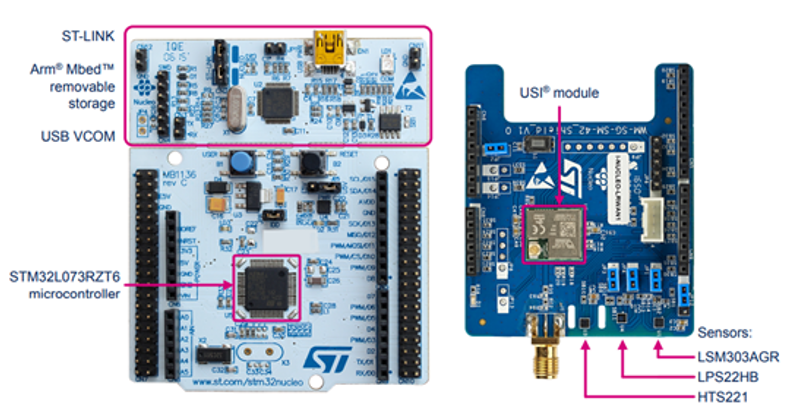
End Node Setup and Working
The end node is powered up through the CN1 connector with a USB Mini-B cable. The Nucleo-L073RZ and Lora expansion board are stacked one on top of the other. The baseboard acts as AT master and the LoRa shield (expansion board) acts as AT slave. The boards communicate using a logic level universal asynchronous serial port (UART). The shield board is free-loaded with AT slave firmware. An application program, written using C language is flashed onto the baseboard. It initiates the reading of the sensor data and sends it through AT commands to the shield board. The uplink data which consists of all the sensor data, GPS data, and FSR data are transmitted by shield board on the basis of the selected frequency band and selected SF and data rate (DR).
The application also reads FSR and GPS module data. FSR is connected to the baseboard using analog input pins. GPS module is connected to the base board using transmit data and receive data pins. GPS module has independent firmware which captures position coordinates at a regular rate. This data is sent to the baseboard. The application program in the baseboard uses a hardware interrupt to receive the GPS data.
External Sensors
A Force Sensitive Resistor and a GPS module are externally interfaced with the end node.
- FSR: An FSR is a force-sensitive resistor. As pressure is applied on the sensing pad, the resistance value changes. FSR sensors are used in our project to detect the presence of vaccine vials. All values beyond a certain voltage value is considered as 1(present), else as 0(absent).
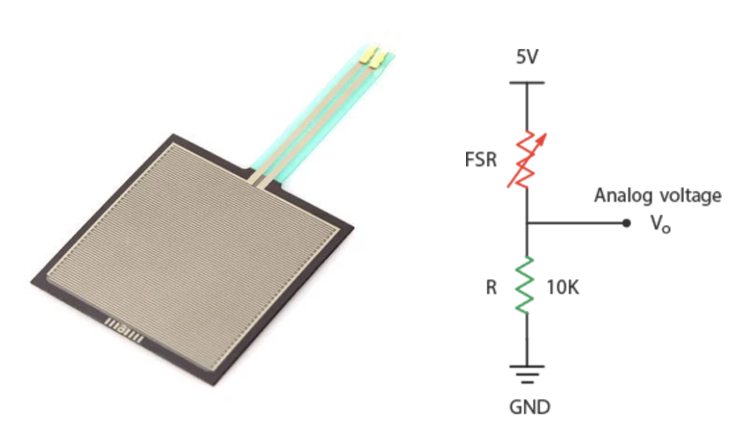
- GPS: The NEO-6M GPS receiver module communicates with end node using USART communication. The GPS module receives information such as latitude, longitude, altitude, etc. from the satellites. This data is in the form of a NMEA string. We can thus track the vaccine chamber using this module.
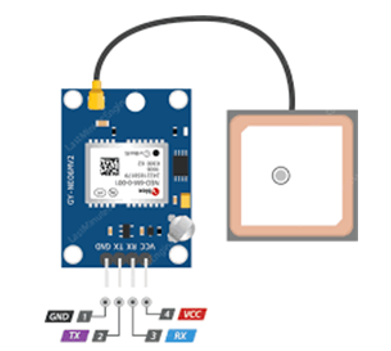
- Automated Downlink System: A blue LED is externally connected to the end device to mimic an alert system. If the vaccine vial status changes from 1 to 0, an automatic downlink message is sent from the application server to the end node. This turns the LED on.
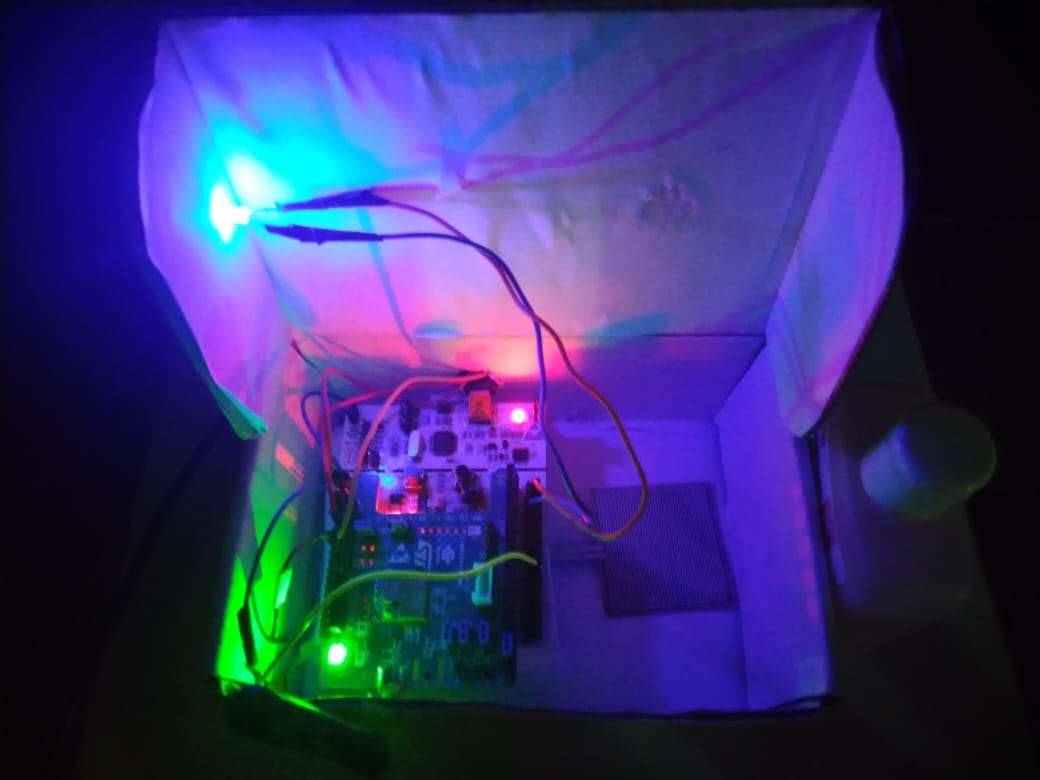
LoRaWAN Gateway
Gateways are packet forwarders or routers. They contain antennas that receive broadcasts from End Devices and send data back to End Devices. The gateway must be registered on a LoRaWAN network before use. A gateway receives LoRa messages from end devices and simply forwards them to the LoRaWAN network server. The Gateway is connected to the internet and can relay data to the network server. IP traffic from the gateway to the network server can be backhauled through Cellular (3G/4G/5G), Wi-Fi, Ethernet, Fibre-optic, or 2.4 GHz radio links.
The LoRaWAN gateway is based on the STMicroelectronics NUCLEO-F746ZG Nucleo board and RisingHF LRWAN_GS_HF1 LoRa® HF band gateway expansion board. The gateway is automatically adaptive to the spreading factor from SF12 to SF7 in each of the 8 channels. It supports LoRaWAN protocol Class A and Class C. It is Ethernet compliant with IEEE-802.3-2002.
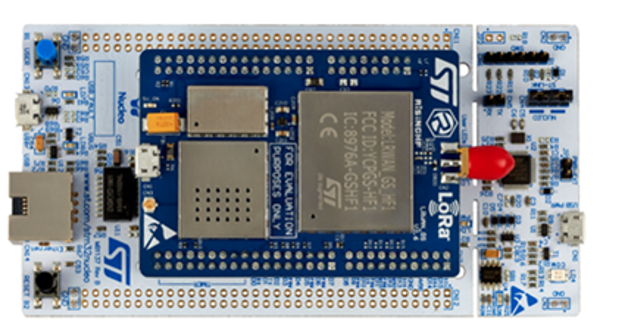
Network Server
The LORIOT network server acts as the interface between the Gateway and the user interface. It receives the raw data from the gateway which can be used when desired. The Network Server acts to eliminate duplicate packets, manages security and data rates.
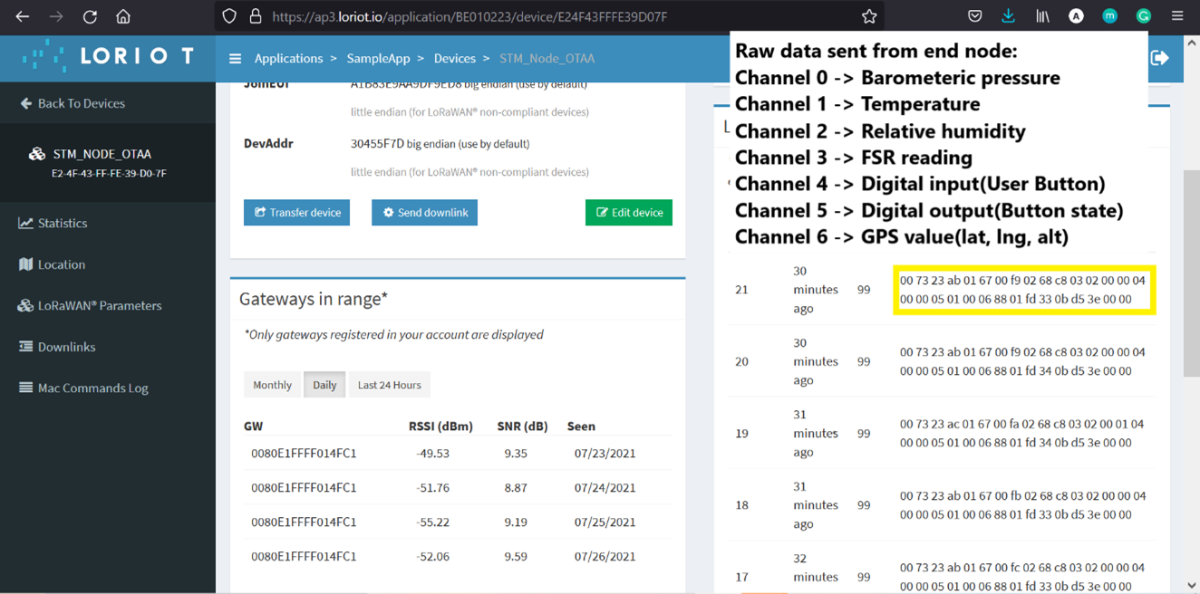
User Application
The user web application is built using ReactJS. ReactJS is a front-end JavaScript framework. React provides a modular and easy dynamic platform for user interface development. The web application has the following features:
- Vaccine Availability Query System: The web application uses the COWIN API to query the availability of vaccines across medical centers with respect to date and pin code. Fig 3 shows the vaccine availability query system.
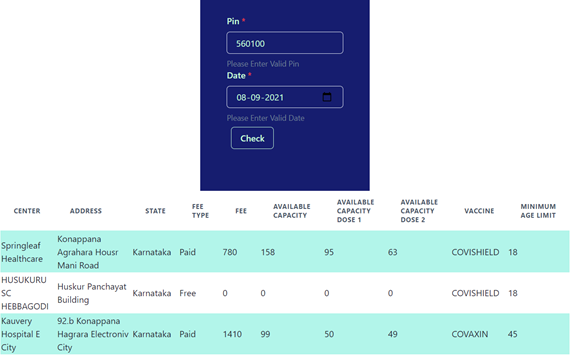
- Analysis Dashboard: The dashboard displays network parameters, RSSI, and SNR, with a line graph. Sensor data namely temperature, pressure, humidity is also displayed with a circular bar graph. Live Tracking using GPS data is rendered on a map. The application also automatically generates a report of the collected data and sends it to the user’s email ID. The FSR sensor which is used for checking the presence of the vaccine vial is constantly monitored. An automatic downlink alert is sent if the vaccine is removed.
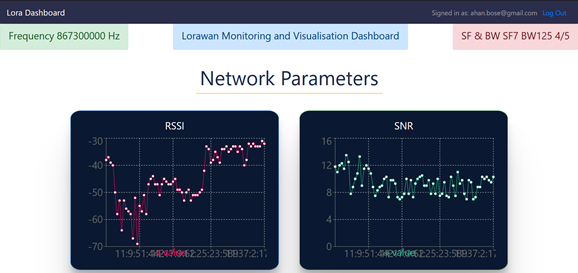
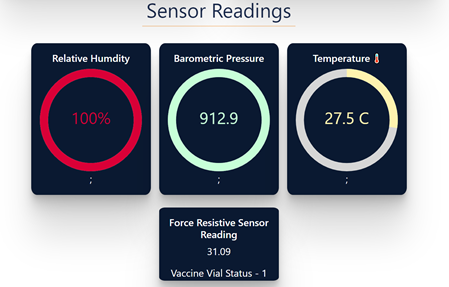
- Live Tracking: The web application receives GPS data from the GPS sensor interfaced externally with the end node. The application can track the live location of the vaccine cold storage.

- Report Generation: The web application can automatically mail the report to the user, utilizing the dashboard for analysis or monitoring. The report is mailed to the registered email ID.
Testing and Analysis
The special properties of LoRa, especially the low susceptibility to interference, the low path loss and the very good building penetration, enable very high ranges even in urban environments. To test these features, range and penetration tests were carried out in two different locations.
Parameters that affect the range and quality of signal
To analyze the data and to optimize it, a few parameters are to be defined and understood.
- SNR: Signal-to-Noise Ratio (SNR) is the ratio between the received power signal and the noise floor power level. The noise floor is an area of all unwanted interfering signal sources which can corrupt the transmitted signal and therefore re-transmissions will occur. If SNR is greater than 0, the received signal operates above the noise floor. Similarly, if SNR is smaller than 0, the received signal operates below the noise floor. Normally, the noise floor is the physical limit of sensitivity; however, LoRa works below the noise level. Typical LoRa SNR values are between: -20dB and +10dB
- RSSI: The Received Signal Strength Indication (RSSI) is the received signal power in mW and is measured in dBm. This value can be used as a measurement of how well a receiver can “hear” a signal from a sender. The RSSI is measured in dBm and is a negative value. The closer to 0 the better the signal is. Typical LoRa RSSI values are: RSSI minimum = -120 dBm.
Testing
The test was conducted in and around the campus of PES University, Bengaluru. The setup included a stationary gateway placed at a high altitude to achieve maximum range and minimum interference. Meanwhile, the end node was carried to different locations.
The signals parameters RSSI and SNR were tested against the distance of the end node from the gateway. Further, the temperature, pressure, humidity readings were noted down at each location. The end device was also tracked live on a map that displayed the accurate latitude and longitude coordinates.
In the figures below, we observe the SNR and RSSI measured with distance from the gateway at PES University. We observe that despite the fall in SNR below the noise floor the signal is still being received.


Analysis
The analyzed data confirms that the SNR drops below the noise floor(0 dB line) as the distance from the gateway increases, however, LoRaWAN is still able to receive the data without errors. This confirms the application of Chirp Spread Spectrum modulation and the postulates of the popular Shannon Hartley Theorem.
We can conclude, LoRaWAN is ideal for receiving signals at large distances and is relatively immune to noise interference.
Further, we can observe that the RSSI reduces with an increase in distance as well. The closer the RSSI is to 0 dB the stronger the signal.
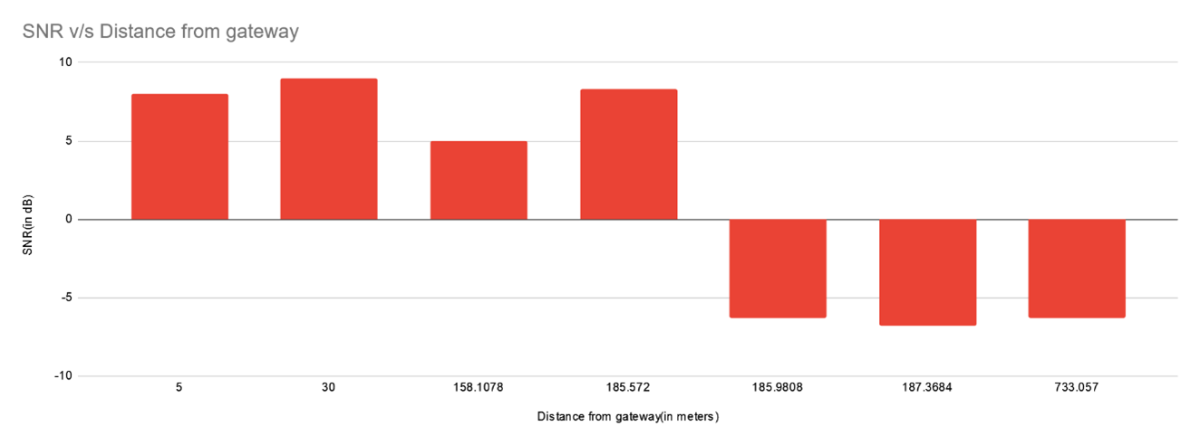
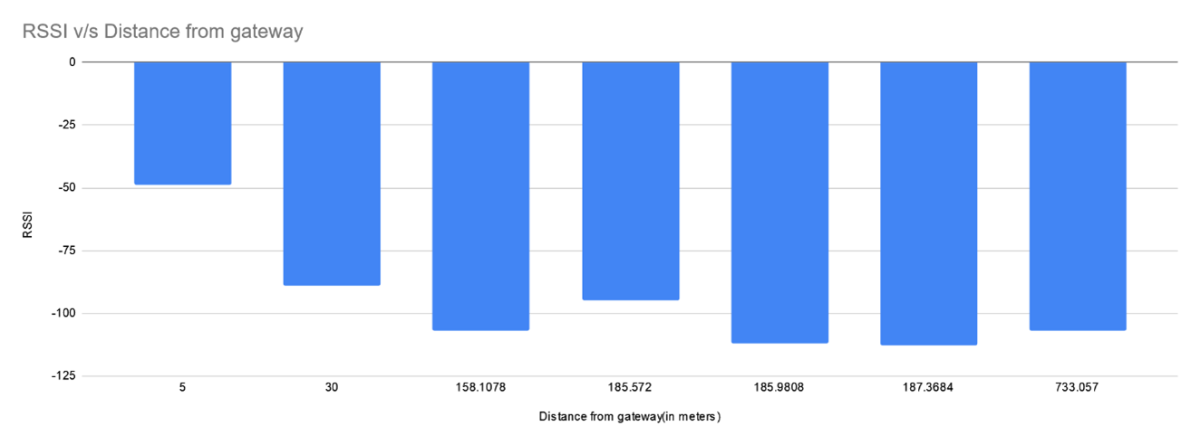
Conclusions
LoRaWAN is a robust, noise-resistive long-range communication protocol. It is capable of receiving signals below the noise level and long distances. It is ideal for real-time communication from sensors and for issuing real-time alerts.
The proposed LoRaWAN based vaccine cold storage monitoring provides an energy-efficient methodology for the safe storage and transport of vaccines while preserving their efficacy. It also provides security against unauthorized removal of vaccines from storage.
It serves as an ideal monitoring system, providing the user with real-time data on signal parameters. Users are also able to generate reports and save observations with ease.
